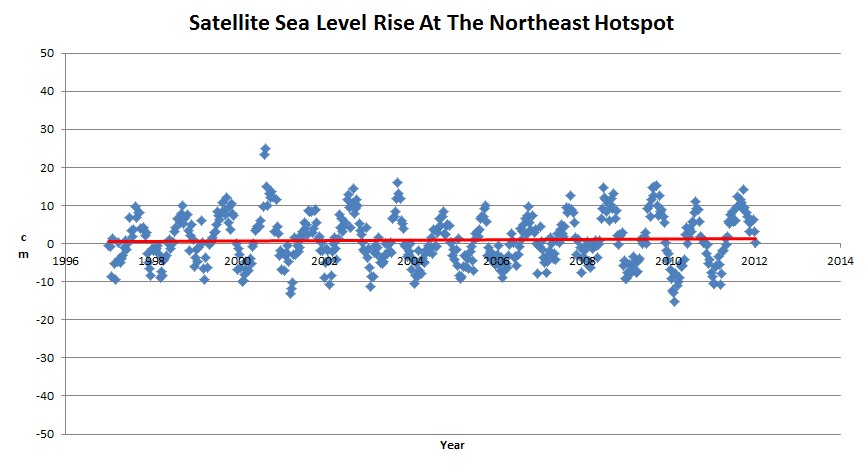The USGS published a paper last week claiming that sea level between Cape Hatteras and Cape Cod was rising much faster than the global average. The graph above shows the average rise over the last 15 years, as measured by satellites at the five locations shown above.
It turns out that the hot spot is actually a cold spot, with sea level rising at 1.7 mm/year over the last 15 years – just over half the global average.
The geniuses at USGS are failing to account for the effects of glacial rebound and subsidence in their study. Then they went and fantasized some theories about global warming driven ocean currents – based on their useless data.
Glacial rebound from the last ice age is not caused by CO2, unless you have the IQ of a turnip.




Even if the sea level rise on the east coast was above the global average, it still wouldn’t be nothing much to complain about because, contrary to alarmists beliefs sea level is rising at a linear rate, which means, it’s NOT ACCELERATING, the change from year to year is the SAME and has been the same since reliable record keeping began.
“The geniuses at USGS are failing to account for the effects of glacial rebound and subsidence in their study.”
I think the USGS are competent enough to know about glacial rebound and subsidence.
The alternatives? The USGS has people who:
A) are lying sacks of CACC;
B) follow Schneider’s advice to be effective rather than honest;
C) face a budget cutting disaster if they don’t fabricate sea level hysteria;
D) need to save the planet from the human infestation.
Since all climate scientists are cherry-picked cherry pickers, I choose (D).
I think you are being extremely unkind to turnips!
Paul Homewood , my thoughts exactly. Every good gardner appreciates the value of a good turnip. We plant two or three varieties here. This insulting of lofty vegetables has to stop. They have value, unlike the AGW crowd.
I just realized the parallel of this USGS study to the tropospheric hot spot controversy. Since direct measurements of troposphere temperatures show no hot spot, the climate crusaders resorted to an indirect proxy of wind shear to estimate temperature, and voila!- a tropospheric hot spot can be made to appear from an ocean of noise.
We also have no data that directly shows a slowing of ocean currents due to global warming or whatever. Instead, an indirect proxy is created to infer a change in ocean currents. Once again, climate doom can be made to appear from an ocean of erroneous data analysis.
How does one ask a journal to post-review a paper? Willful ignorance beyond the pale. We know the authors won’t ask for a retraction, but there should be an objective process for removing junk from the body of knowledge.
Scientific zit removal…..
In truth, I prefer (almost) pure Tide Gauge data. These records tend to be uncorrupted and go back a few years too:
http://www.psmsl.org/data/obtaining/
The Toucan Equations
http://www.colderside.com
at FAQ 11 and up, were completed prior to GIA and are likely accurate even without the Jason II data being available when they were created.
Result of an opening Arctic??? Asian and North American aquifer replenishment, early fall snow deposition, later spring melt, and acceleration of Sea Level Rise “leveling off,” and declining before mid century.
A tide gauge resting on subsiding land is not much use for measuring changes in the level of the ocean.
A satellite resting on a gravity model is not much use for measuring changes in the level of the ocean.
“A tide gauge resting on subsiding land is not much use for measuring changes in the level of the ocean.”
Actually it is the BEST way to gauge (PI) the sum total of local effects that concern most people – answering the rate of water intrusion question for your own locality. It matters not whether land sinks or ocean rises insofar as your beach house is concerned, but the local tide gauge gives a fairly precise local rate of change to bank (or build a dike) on.
For example, the NE coast from Cape Cod, MA, to Rockland Maine, is fairly steady as far as the tide gauges show, while Boston, with its new skyscrapers built on partial landfill and frangible bedrock, shows a “sea-level” rise (actually sinking land) over the past 30 years, just when the building boom began. Not too much problem figuring out what happened here, but the satellites won’t give you the same info.
The problem is that they drew conclusions about ocean currents based on land subsidence measurements
you’re absolutely right, but you, as a thinking individual, don’t have to!